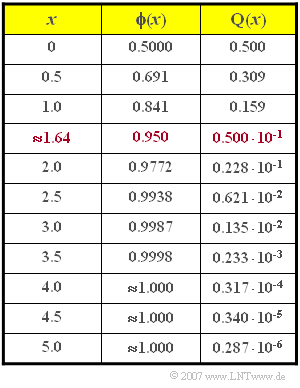It is known from a digital transmission system that it can be approximated by a BSC model ("Binary Symmetrical Channel") with error probability $p$.
For verification, the bit error rate is to be determined by comparing the sink symbol sequence $ \langle v_\nu \rangle $ with the source symbol sequence $ \langle q_\nu \rangle $ and finding the error sequence $ \langle e_\nu \rangle $. Thereby holds:
- $$e_\nu = \left\{ \begin{array}{c} 0 \\ 1 \\ \end{array} \right.\quad \begin{array}{*{1}c} {\rm{for}} \\ {\rm{for}} \\ \end{array}\begin{array}{*{20}c} v_\nu = q_\nu \hspace{0.05cm}, \\ v_\nu \ne q_\nu . \\ \end{array}$$
The bit error rate is an approximation for the bit error probability $p$:
- $${\rm BER} = \frac{1}{N}\cdot\sum_{\nu=1}^N e_\nu.$$
The larger the simulation parameter $N$ is chosen, the more accurate is this approximation.
From "Exercise 3.7" in the book "Stochastic Signal Theory" it is known that the random variable "BER" is actually binomially distributed, but can be approximated with good approximation by a (discrete) Gaussian distribution with mean $p$ and standard deviation $\sigma$:
- $$\sigma = \sqrt{\frac{ p\cdot (\rm 1- \it p)}{N}}.$$
Notes:
- The exercise belongs to the chapter "Error Probability for Baseband Transmission".
- Reference is also made to the chapter "Gaussian Distributed Random Variables" in the book "Stochastic Signal Theory".
- In the table some values of the Gaussian error functions ${\rm \phi}(x)$ and ${\rm Q}(x)$ are given.
Questions
Solution
- $\rm BER$ is the quotient of the number $n_{\rm B}$ of detected symbol errors and the number $N$ of all simulated symbols and thus actually a relative frequency.
- The probability that ${\rm BER} = p$ is always exactly zero, since $\rm BER$ is a continuous random variable.
- However, the probability that $\rm BER$ lies in a narrow interval around $p$ increases as $N$ increases.
(2) The standard deviation of the Gaussian random variable $\rm BER$ with $N = 10^6$ and $p = 10^{-2}$ is given by
- $$\sigma = \sqrt{{ p\cdot (\rm 1- \it p)}/{N}}\approx \sqrt{{ p}/{N}}\hspace{0.1cm}\underline {= 10^{-4}}\hspace{0.05cm}.$$
(3) The probability that the $\rm BER$ takes a value outside the range
$0.95 \cdot p$ ... $1.05 \cdot p$ is obtained with $\varepsilon = 5 \cdot 10^{-4}$ $(p = 10^{-2})$ as follows.
- $${\rm Pr} \left( {\rm BER} < 0.95 \cdot 10^{-2} \right) = {\rm Pr} \left( {\rm BER} > 1.05 \cdot 10^{-2} \right) = {\rm Q} \left({\varepsilon}/{\sigma} \right)$$
- $$\Rightarrow \hspace{0.3cm}{\rm Pr} \left( |{\rm BER} - p| > \varepsilon \right) = 2 \cdot {\rm Q} \left( \frac{5 \cdot 10^{-4}}{10^{-4}} \right) = 2 \cdot 0.287 \cdot 10^{-6}\hspace{0.1cm}\underline {= 0.00574 \cdot 10^{-4}}\hspace{0.05cm}.$$
(4) With $p = 10^{-4}$, the comparable probability is:
- $${\rm Pr} \left( |{\rm BER} - 10^{-4}| > 0.05 \cdot 10^{-4} \right) = 2 \cdot {\rm Q} \left( {\varepsilon}/{\sigma} \right);\hspace{0.5cm} \text{with}\hspace{0.5cm}\sigma \approx \sqrt{{ p}/{N}}= 10^{-5}\hspace{0.05cm}, \hspace{0.3cm}\varepsilon = 5 \cdot 10^{-6}\text{:}$$
- $$\Rightarrow \hspace{0.3cm}{\rm Pr} \left( |{\rm BER} - 10^{-4}| > 0.05 \cdot 10^{-4} \right) = 2 \cdot {\rm Q} \left( \frac{5 \cdot 10^{-6}}{10^{-5}} \right) = 2 \cdot 0.309 \hspace{0.1cm}\underline {= 0.618} \hspace{0.05cm}.$$
(5) This condition can be formulated with $\varepsilon = 5 \cdot 10^{-6}$ as follows:
- $${\rm Q} \left( {\varepsilon}/{\sigma} \right) < 0.1 \hspace{0.3cm}\Rightarrow \hspace{0.3cm} {\varepsilon}/{\sigma} > {\rm Q}^{-1}(0.05) \approx 1.64 \hspace{0.3cm}\Rightarrow \hspace{0.3cm} \frac{\varepsilon^2}{\sigma^2}\approx \frac{\varepsilon^2 \cdot N}{p}> 1.64^2 = 2.69$$
- $$\Rightarrow \hspace{0.3cm} N > \frac{2.69 \cdot p}{\varepsilon^2}= \frac{2.69 \cdot 10^{-4}}{25 \cdot10^{-12}}\hspace{0.1cm}\underline {\approx 10.8 \cdot 10^{6}}\hspace{0.05cm}.$$
